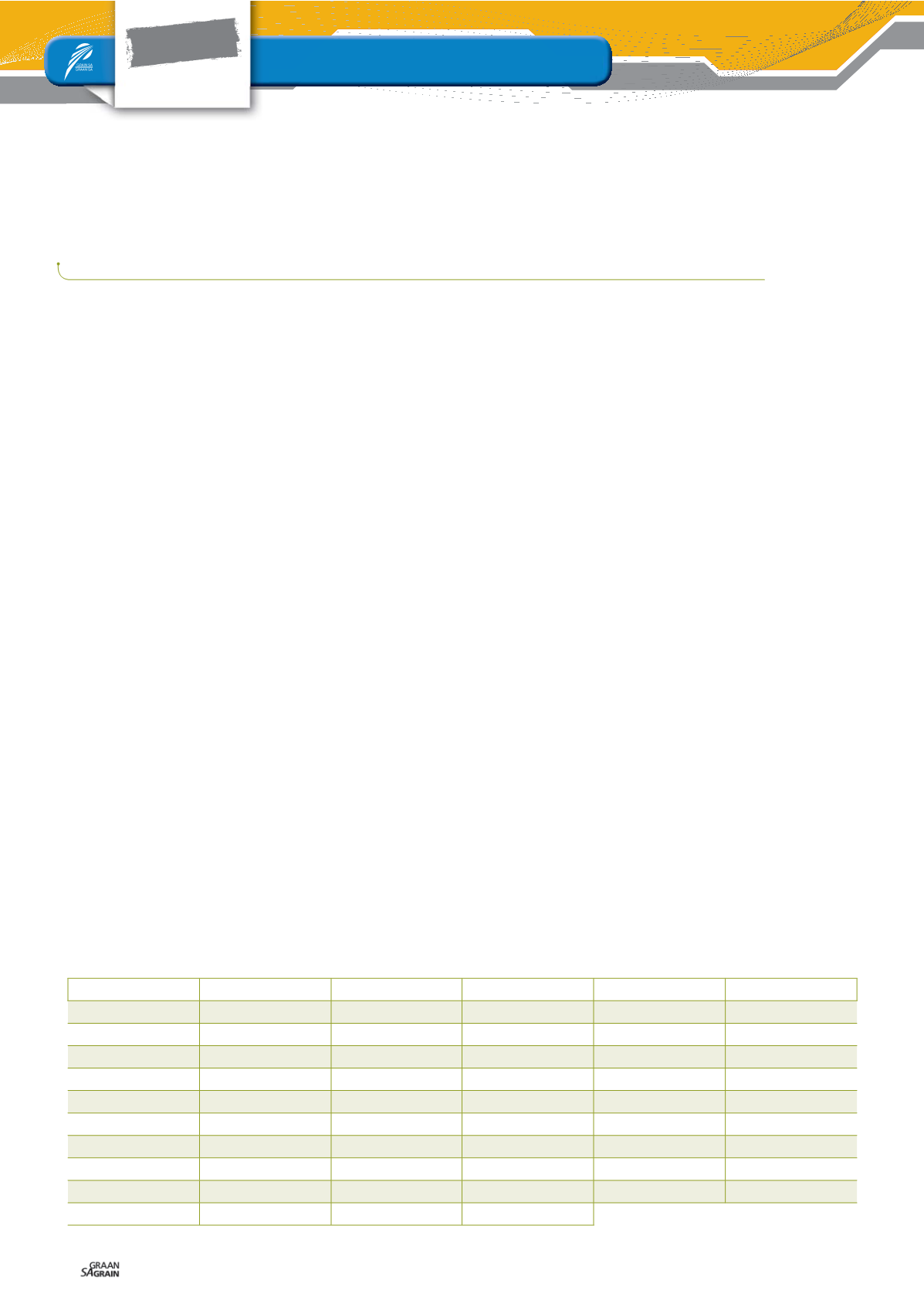

September 2017
80
Sclerotinia stem rot on soybean
in South Africa
S
clerotinia
sclerotiorum
is a fungus
that feeds on soybean tissue, caus-
ing stem rot of soybean. This fun-
gus is found all over the world and
it has a wide range of host species including
important South African crops like soybean,
sunflower and canola.
The fungus thrives in wet and cold condi-
tions and can result in extreme yield losses
under favourable environmental conditions.
The stem rot starts as a white mould grow-
ing on the surface of infected plants, as
seen in
Photo 1
and
Photo 2
.
Water-soaked lesions then follow and vas-
cular tissue is replaced with fungal survival
structures called sclerotia (
Photo 3
), caus-
ing wilting and death of plant cells. Sclerotia
can also be found in soybean pods, as seen
in
Photo 4
, possibly reducing the quality
of seeds.
The cell death is known to be due to toxic
substances, the main virulence factor being
oxalic acid, which is secreted by the fungus.
However, the mechanisms involved in this
process are still unclear.
Seed testing
Losses caused by stem rot are mainly due
to reduced seed quality and lower yields.
Seed testing in terms of health, vigour and
germination is thus important to assess
quality of seeds marketed to customers.
Seed health is important as pathogens as-
sociated with soybean seeds can cause fast-
er deterioration of seeds in storage, a rise in
soil- and seed-borne inoculum, a decrease
in seedling emergence or germination of
seeds, or they could cause disease symp-
toms on mature plants, e.g. blights and leaf
spots. Seed health testing will provide in-
sights into which fungi are present in South
African soybean seed, and whether some of
these fungi are pathogenic on soybean.
The seed health of 29 different soybean
cultivars (
Table 1
) was determined using
a traditional incubation method. Possibly
pathogenic fungal species isolated included
Bipolaris, Chaetomium, Macrophomina
and
Fusarium
species. Results from seed health
testing are presented in
Graph 1
.
Macropho-
mina phaseolina
could possibly cause char-
coal rot on soybean roots and stems.
The seed health was calculated by dividing
the number of fungal isolates per cultivar
by the 400 seeds tested and converted to a
percentage. From the results of seed health
testing, growers can choose the optimal cul-
tivars for planting in each region, based on
amounts of pathogenic microflora present
in seed. This could prevent yield losses due
to reduced seed-borne inoculum levels.
Germination tests are used to assess the
quality of seeds, which has a direct influ-
ence on the productivity of crops. Seeds
with lower vigour and viability usually have
lower germination rates. Accelerated age-
ing is a vigour test commonly used for soy-
bean where seeds are rapidly aged under
conditions of high temperature and humid-
ity. This test estimates the storage potential
and field emergence of soybean.
In this study the normal germination per-
centages and accelerated ageing germina-
tion percentages of 29 soybean cultivars
planted in South Africa were determined.
From the results, it was found that cultivar
LS 6161 R had the best normal germination,
with a percentage of 96%. This cultivar’s ac-
celerated ageing percentage was also very
good at 86%.
PAN 1664 R was the cultivar with the low-
est germination percentage of only 53%,
as well as being the cultivar with the lowest
accelerated ageing germination percentage
of 34,5%.
Cultivars NS 5909 R and LS 6466 R showed
accelerated ageing germination percent-
ages higher than the normal germination
percentages, demonstrating that these
cultivars have good vigour, and should still
have relatively good germination at high
temperatures and relative humidity.
The highest accelerated ageing germination
percentage of 89% was recorded for culti-
vars PAN 1614 R and PAN 1729 R.
Resistance screening
against
S. sclerotiorum
Since stem rot caused by
S. sclerotiorum
can result in extensive damage, many con-
trol measures have been tested, includ-
ing partial host resistance, but these have
proven to be fairly ineffective. Due to the
ineffectiveness of management practices
like chemical control, biological control and
cultural practices, the identification and/or
development of cultivars that confer resist-
ance to the pathogen could provide more
effective disease management options.
FOCUS
Integrated pest control
Special
LIEZL VAN DER HOVEN
and
PROF JACQUIE VAN DER WAALS,
Department of Plant and Soil Sciences, University of Pretoria and
DR MARIETTE TRUTER
, ARC-Vegetable and Ornamental Plants, Roodeplaat
CULTIVAR NUMBER CULTIVAR NAME CULTIVAR NUMBER CULTIVAR NAME CULTIVAR NUMBER CULTIVAR NAME
1
LS 6240 R
11
PAN 1664 R
21
LS 6261 R
2
LS 6444 R
12
DM 5953 RSF
22
DM 6.2i RR
3
PAN 1454 R
13
LS 6453 R
23
LS 6164 R
4
LS 6146 R
14
PAN 1521 R
24
LS 6161 R
5
PHB 94 Y 80 R
15
PAN 1500 R
25
PAN 1614 R
6
LS 6248 R
16
NS 5909 R
26
NS 6448 R
7
NS 5009 R
17
PAN 1513 R
27
DM 6.8i RR
8
DM 5.1i RR
18
LS 6466 R
28
NS 7211 R
9
PHB 95 Y 20 R
19
PAN 1666 R
29
PAN 1729 R
10
PAN 1583 R
20
PAN 1623 R
TABLE 1: SOYBEAN CULTIVARS USED IN SEED HEALTH TESTING.
De Beer and De Klerk, 2015

















